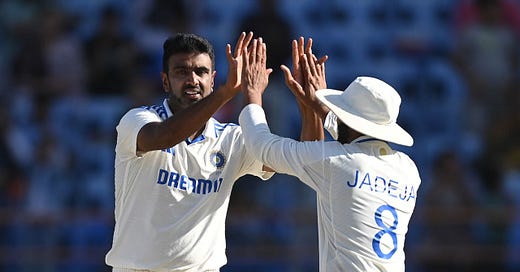During the 2023 Border-Gavaskar Trophy series, Karthik Krishnaswamy of ESPNcricinfo observed that the unprecedented rise of the around-the-wicket angle between same-handed batting-bowling pairs in Test cricket in India likely had to do with the nature of contemporary pitches in the subcontinent. The logic was this: by going around the stumps, the spinner who specializes in turning the ball into a batter can threaten the stumps more, if he knows in advance that he is going to turn it big.
Some verses from the original article are quoted below:
Why has this happened? The short answer, quite simply, is the pitches. There has been sharp and early turn, to varying degrees, in all three Tests so far, but the pitches in Nagpur, Delhi and Indore haven't offered a great deal of bounce... This has heightened the need to keep the stumps in play and target bowled and lbw rather than slip and bat-pad catches. This, first of all, has meant that the ball turning into the batter has been a bigger threat than the one turning away... You can turn the ball into a batter and hit the stumps from over the wicket too, but from around the wicket on a turning track, you can pitch the ball in line with the stumps, turn it, and still hit the stumps.
The vast majority of the chatter surrounding India's spinners during the ongoing New Zealand series has been focused on the pace differential between the India and New Zealand spin departments. This is interesting in its own right: are the India spinners bowling faster speeds because they have grown used to operating on turners, conditions in which they find turn irrespective of their speeds, or is it because the New Zealand batters have swept hard and used their feet? Or is it the influence of newfound T20 success on their Test techniques?
(For what it's worth, I think it's more to do with the first two than the last one. In fact, lately I've been wondering whether it's possible that the India spinners' intuition that it is optimal to bowl faster speeds on turning wickets is accurate in general but that the tradeoff in turn from bowling fast may be higher on some types of turners than on others.)
Unfortunately, I also think that this impassioned discussion has kept us from mulling about a related (and possibly slightly less competitively significant) aspect of their techniques. That is this: the bowling load of India’s fingerspinners to same-handed batters from around the wicket, which currently seems out of tandem with the conditions they’re operating in.
Notice how the assumption of big turn is important to the usability of the around-the-wicket angle. Without big turn, the ball will either zoom past the offstump when pitched in line with the stumps, or the bowler will be forced to bang the ball in outside legstump, thereby eliminating the possibility of lbw.
This seems to have afflicted the India spinners of late. They picked up the benefits of operating from this angle on the extreme turners of the 2023 Border-Gavaskar series, and now, on pitches where this angle is theoretically less useful, they seem unable to shake off this habit. They are, effectively, stuck in a bad equilibrium.
Jadeja in particular is an interesting case study. The left-arm spinner's T20 stocks rose sky-high when he discovered a way of stifling southpaw batters in 2023: faster trajectories and an increased bowling load from around the wicket. Today, both these aspects seem to have seeped into his Test game. My friend Stephen noted on Twitter that his average speed has increased by a good three to four kmph since 2019, while in Tests since the 2023 Australia-India series he has bowled 49% of his balls to left-handed batters from around the wicket (as opposed to 18% before).
Even in conditions as seam-friendly as in Bengaluru last week, Ashwin bowled 41% of his balls to right-handers from this angle. Even if we trim down the sample to all first-innings outings for the India fingerspinners in 2024, they have released a good 47% of their balls from this angle.
Now - this does not necessarily spell trouble. In fact, the raw averages suggest that India's spinners have done just as well from around the wicket as they have from over in the New Zealand series.
But remember when I asked you to take note that big turn is a prerequisite for wicket-taking from the around-the-wicket angle? Notice, in particular, that there are only two ways of bringing the stumps into play from around the wicket against same-handed batters when there is no big turn. Either you must pitch the ball outside the legstump, which takes lbw out of the equation, or you must pitch the ball fuller so that ball doesn't hold its line and get taken away from the stumps.
A significant portion of the India spinners' fullish lengths in this Test series can be explained by the fact that they have bowled from around the wicket more.
The uncharitable way of interpreting India's recent travails in the longest format is as the aftershocks of their choice to roll out rank-turners between 2021 and 2024. Perhaps this made their batters lose touch with the art of defensive batting and their bowlers the subtilities of pace variation. But then perhaps it has also meant that their twirlers, once masters of the art of creating angles, have shoehorned the around-the-wicket ploy as their one true line of attack™. I guess you could say what goes around comes around.







Good little analysis 🙏